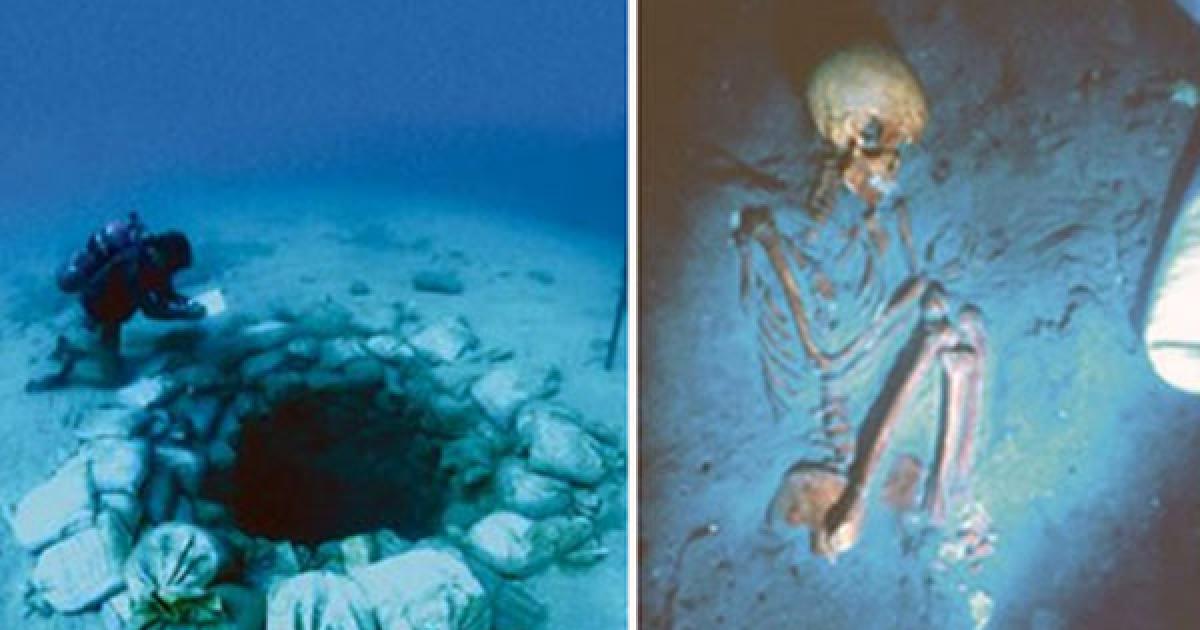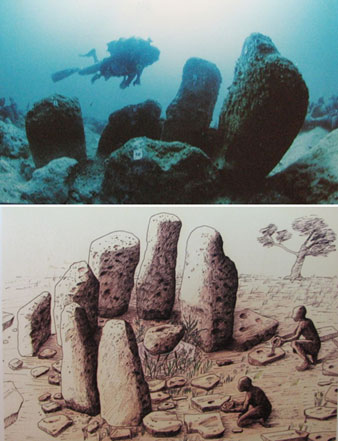
The 9,000-year-old underground megalithic settlement of Atlit Yam
Not far off the coast of the village of Atlit in the Mediterranean Sea, near Haifa in Israel, lies the submerged ruins of the ancient Neolithic site of Atlit Yam. The prehistoric settlement, which dates back to the 7 th millennium BC, has been so well preserved by the sandy seabed that a mysterious stone circle still stands as it was first erected, and dozens of human skeletons lay undisturbed in their graves. Atlit Yam is one of the oldest and largest sunken settlements ever found and sheds new light on the daily lives of its ancient inhabitants.
Today, Atlit Yam lies between 8 – 12 metres beneath sea level and covered an area of 40,000 square metres. The site was first discovered in 1984 by marine archaeologist Ehud Galili, and since then underwater excavations have unearthed numerous houses, stone-built water wells, a series of long unconnected walls, ritual installations, stone-paved areas, a megalithic structure, thousands of flora and faunal remains, dozens of human remains, and numerous artifacts made of stone, bone, wood and flint.
At the centre of the settlement, seven megaliths (1.0 to 2.1 metres high) weighing up to 600 kilograms are arranged in a stone semicircle. The stones have cup marks carved into them and were once arranged around a freshwater spring, which suggests that they may have been used for a water ritual. Another installation consists of three oval stones (1.6 - 1.8 metres), two of which are circumscribed by grooves forming schematic anthropomorphic figures.

Top: A diver examines megaliths at Atlit Yam. Bottom: Artist’s reconstruction of stone formation. Image source: Wikimedia
Another significant structural feature of the site is the stone-built well, which was excavated down to a depth of 5.5. metres. At the base of the well, archaeologists found sediment fill containing animal bones, stone, flint, wood, and bone artifacts. This suggests that in its final stage, it ceased to function as a water-well and was used instead as a disposal pit. The change in function was probably related to salinization of the water due to a rise in sea-level. The wells from Atlit-Yam had probably been dug and constructed in the earliest stages of occupation (the end of the 9th millennium BC) and were essential for the maintenance of a permanent settlement in the area.
The ancient artifacts unearthed at Atlit Yam offer clues into how the prehistoric inhabitants once lived. Researchers have found traces of more than 100 species of plants that grew at the site or were collected from the wild, and animal remains consisted of bones of both wild and domesticated animals, including sheep, goat, pig, dog, and cattle, suggesting that the residents raised and hunted animals for subsistence. In addition, more than 6,000 fish bones were found. Combined with other clues, such as an ear condition found in some of the human remains caused by regular exposure to cold water, it seems that fishing also played a big role in their society. The archaeological material indicates that Atlit-Yam provides the earliest known evidence for an agro-pastoral-marine subsistence system on the Levantine coast. The inhabitants were some of the first to make the transition from being hunter-gatherers to being more settled farmers, and the settlement is one of the earliest with evidence of domesticated cattle.
Human remains reveal oldest known case of Tuberculosis
Ten flexed burials encased in clay and covered by thick layers of sand were discovered, both inside the houses and in the vicinity of Atlit Yam, and in total archaeologists have uncovered 65 sets of human remains. One of the most significant discoveries of this ancient site is the presence of tuberculosis (TB) within the village. The skeletons of a woman and child, found in 2008, have revealed the earliest known cases of tuberculosis in the world. The size of the infant's bones, and the extent of TB damage, suggest the mother passed the disease to her baby shortly after birth.
What caused Atlit Yam to sink?
One of the greatest archaeological mysteries of Atlit Yam is how it came to be submerged, a question that has led to heated debated in academic circles. An Italian study led by Maria Pareschi of the Italian National Institute of Geophysics and Volcanology in Pisa indicates that a volcanic collapse of the Eastern flank of Mount Etna 8,500 years ago would likely have caused a 40 metre high tsunami to engulf some Mediterranean coastal cities within hours. Some scientists point to the apparent abandonment of Atlit Yam around the same time, and the thousands of fish remains, as further evidence that such a tsunami did indeed occur.
However, other researchers have suggested that there is no solid evidence to suggest a tsunami wiped out the settlement. After all, the megalithic stone circle still remained standing in the place in which it had constructed. One alternative is that climate change caused glaciers to melt and sea levels to rise and the settlement became flooded by a slow rise in the level of the Mediterranean that led to a gradual abandonment of the village. Whatever the cause of the submerging of the settlement, it was the unique conditions of clay and sandy sediment under salty water that enabled this ancient village to remain so well preserved over thousands of years.
Featured image: A diver explores Atlit-Yam (Credit: Israel Antiquities Authority) and a human skeleton lies uncovered on the sea floor.
References
The Pre-Pottery Neolithic Site of Atlit-Yam – Israel Antiquities Authority
Tsunami or melting glaciers: What caused ancient Atlit to sink? – Haaretz
Atlit-Yam, Israel – New Scientist
Earliest confirmed TB case found – BBC News
Atlit Yam: Submerged Ruins of a Neolithic Coastal Settlement – Atlas Obscura
















Comments
From the article, “One alternative is that climate change caused glaciers to melt and sea levels to rise..."
Well, they give us the ‘alternative’ (i.e., more logical) explanation, but they twist it to fit the prevailing climate change mythology/diversion for another angle of deception. Just know that sea levels were much higher (as much as 400/500 feet) PRIOR to the Ice Age (120-130k years ago), which was/is a TEMPORARY condition caused by some huge climatic disruption akin to a 100,000-year nuclear winter. The Ice Age, which emerged SUDDENLY, lowered temps dramatically and thus served to lock up a huge volume of Earth’s water in glaciers. This LOWERED sea levels, possibly as much as 800/900 feet from where they were PRIOR to the Ice Age, but thereafter began to reverse as temps slowly rose, and REMAIN on a path to restore Earth’s natural (pre-Ice Age) equilibrium. So it is logical for the construction of pre-historic stone structures (by pre-historic Ice Age survivors) to have begun tens of thousands of years ago when sea levels were much lower than today, But the climate warming and sea level rise, if unimpeded, will likely continue due to natural dynamics to bring sea levels back to the pre-Ice Age levels. It doesn’t make sense to deny it or fight it via dubious politcal measures. But clearly, we must prepare and make changes to where and how we live. Let’s not overlook that the pre-historic people, whose civilization was destroyed by the calamity that initiated the Ice Age, occupied regions that were probably as HOT or possibly hotter than today, by establishing subterranean dwellings which maintained stable temps ideal for the human body. We may want to start thinking along these lines instead of trying to fight what the planet wants to do with itself.
Nobody gets paid to tell the truth.
Just wondering since they have found skeletal remains at the site is it possible to retrieve DNA from them to determine origin in today’s terms?
The flood happened. There is more evidence to support the accuracy of the Bible than any of your scientific theories.. you just have to look. Although, God has to open your eyes for you to see the truth. If you really want truth you should ask the Creator.
Time is short.
City Kato Zakros at eastern end of Crete is under a similar amount of water.No cata stophic damage !Think the “ Med” just rose ath that time for whatever reason
has risen about 1500 BC
I'm surprised that explanations for the abandonment of Atlit Yam have been focused primarily on its current location many meters below the sea. Since the standing stones appear not to have been disturbed, a truly catastrophic tsunami does not seem likely. Even if the submerging process occurred gradually, the settlement may already have been abandoned.
The standing stones indicate that the occupants of Atlit Yam may have been superstitious, as other Neolithic peoples are believed to have been. With this in mind, it is likely that the settlement was abandoned shortly after the deaths of the mother and child from TB. The occupants may have believed that the site itself had become ill, or possessed by evil spirits. If the people of Atlit Yam felt that the land itself was no longer welcoming, they would have left to find another place to settle.
- DK
Pages